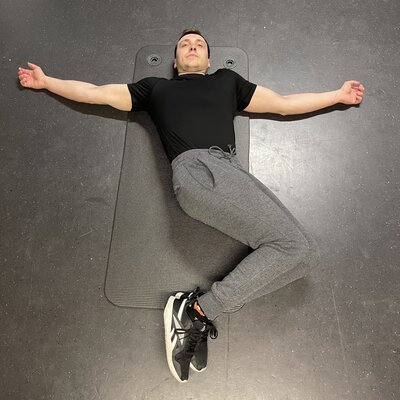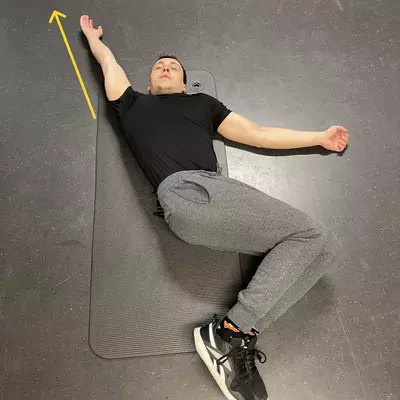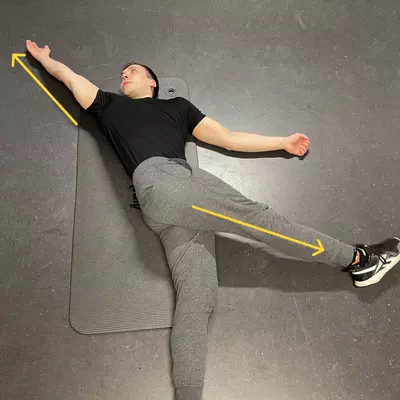Thoracolumbar Fascia stretch – Best Stretches for Back Flexibility
In this article, I will show you how to perform a thoracolumbar fascia stretch to relieve the middle and lower back muscles and the lumbar spine from pain and tension.
You will also learn about thoracolumbar fascia:
- Anatomy and purpose
- Importance of thoracolumbar fascia
- Causes of tight fascia
- Tips when stretching the thoracolumbar fascia
Let’s dive in.
How to Stretch Your Thoracolumbar Fascia
Before starting with stretches for thoracolumbar fascia, perform a warm-up routine. Here is an example of how to warmup:
- Light aerobic activity 5min (jogging)
- Dynamic stretches with back rotation, side flexion, flexion-extension 3×10.
- Prone Back Extension 3×12.
- Deep Squats 3×12.
Now, let me show you thoracolumbar fascia stretching exercises.
Supine Thoracolumbar Fascia Stretch
- Start from a lying on your back.
- Place your arms in shoulder height
- Bend your knees and rotate to one side.
- Hold this stretch for 30s.
Thoracolumbar Fascia Stretch with Shoulder Flexion 120 Degree
- Start from a lying on your back.
- Place one of your arm above your head (around 120 degree shoulder flexion)
- Bend your knees and rotate to one side.
- Protract your shoulder (arrow)
- Hold this stretch for 30s.
Thoracolumbar fascia stretch shoulder flexion 180
- Start from a lying on your back.
- Place one of your arm above your head (around 180 degree shoulder flexion)
- Bend your knees and rotate to one side.
- Protract your shoulder (arrow)
- Hold this stretch for 30s.
Thoracolumar Fascia Stretch Advanced
- Start from a lying on your back.
- Place one of your arm above your head (around 160 degree shoulder flexion)
- Rotate and extend one leg to the opposite side.
- Protract your shoulder (arrow)
- Protract your hip (arrow)
- Hold this stretch for 30s.
Tips & Safety Measures For Thoracolumbar Fascia Stretch
When performing thoracolumbar fascia stretching exercises, you should pay attention to the following aspects:
Breathe deeply during the stretching process to relax and calm your body, thereby reducing the activation of the stretch reflex.
Initiate the stretching slowly, avoiding sudden movements in your back.
Maintain each static stretch for 30 seconds, using the timer for optimal effectiveness.
If you experience pain in your back during stretching, immediately stop stretching and consult with your physician.
Learn more how to perform stretching exercises & step-by-step stretching routines for whole body in the stretching ebook I’ve created.
How Do You Release Thoracolumbar Fascia?
The best possible way to “release” your thoracolumbar fascia is to perform stretches I’ve explained in this article daily.
I would not recommend using a foam roller or any other stretching tools because lower back is a very sensitive area and putting pressure on lower back can damage some structures.
Now that you know the best stretches for thoracolumbar fascia, you just need to motivate yourself to exercise daily.
What is Thoracolumbar Fascia?
The thoracolumbar fascia is a strong and dense connective tissue located in the lower back region.
It consists of three layers: superficial, intermediate, and deep.
Its primary functions are to provide mechanical support, distribute load during movement, and maintain the stability of the spinal column.
It also covers back muscles like quadratus lumborum or erector spinae, and this fascia helps maintain proper posture and protects underlying structures.
Where is the Thoracolumbar Fascia Located?
Thoracolumbar fascia origins from the thoracic region (covering the extensor muscles of the vertebral column). This fascia is attached to the spines of the thoracic vertebrae and ribs.
The lumbar part of this fascia consists of three layers and they attach to lumbar and sacral vertebrae, and ligaments like iliolumbar, lumbodorsal and supraspinal.
Why is Thoracolumbar Fascia Important?
The thoracolumbar fascia is essential for regulating tension in the lumbar and thoracic regions of the spine, as well as in load transfer during movement, standing, or bending.
It is located near the ligaments in the lumbar spine and contributes to stabilizing the lumbar spine during trunk flexion.
This fascia surrounds the muscles of the lumbar and thoracic regions of the spine, meaning that the thoracolumbar fascia supports the functioning of your back muscles.
Additionally, this fascia divides the muscles in the back into compartments.
Thoracolumbar fascia stretch exercises will automatically help you improve the function of this fascia.
What Causes Tight Thoracolumbar Fascia?
Tension in the thoracolumbar fascia can arise in several ways.
The most common cause is a sedentary lifestyle, where the muscles in the lumbar and thoracic spine are inactive and weak, leading to reduced mobility in this region.
With decreased mobility in the thoracic and lumbar areas, the thoracolumbar fascia loses its function, becomes inactive, and tightness in this fascia increases.
Repetitive activities such as lifting objects from the ground or similar actions can increase the risk of muscle strain in the lower back, negatively impacting the health of the thoracolumbar fascia.
Compensatory movements, such as with the lower crossed syndrome, involve overactive hip flexors like iliopsoas, erector spinae, and quadriceps, while the gluteus maximus, abdominal muscles, and hamstrings are weak and inactive.
In this scenario, there is a higher likelihood of developing tightness in the thoracolumbar fascia.









